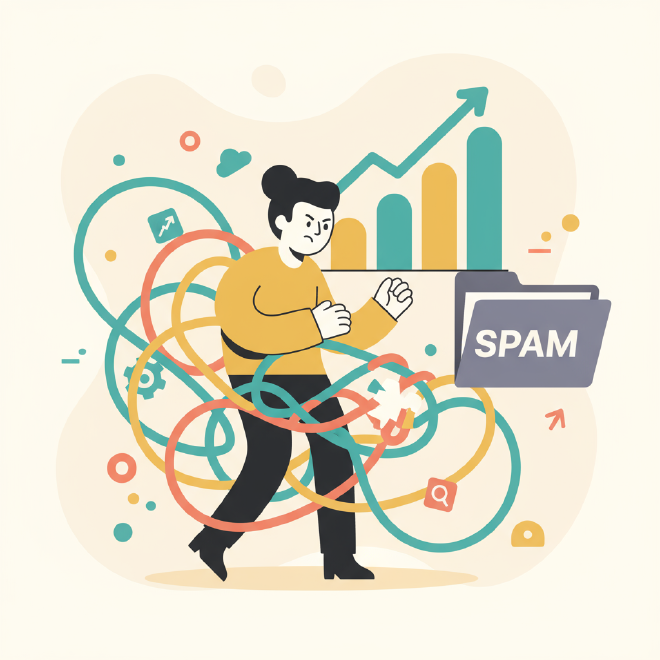E-commerce Email Automation: High-ROI Flows & Deliverability
Table of Contents
title: E-commerce Email Automation Simplified: High-ROI Flows That Convert (Without the Deliverability Headaches) description: Cut through the complexity of e-commerce email marketing. Learn how to implement essential, high-ROI email automation flows that drive sales, boost engagement, and ensure your messages land in the inbox, not the spam folder. keywords: e-commerce email automation, high-ROI email flows, email marketing for online stores, abandoned cart strategy, email deliverability e-commerce, simplify email marketing, welcome series e-commerce, post-purchase emails, review request emails, email marketing platform #
E-commerce Email Automation Simplified: High-ROI Flows That Convert (Without the Deliverability Headaches) #

Let’s be honest: e-commerce email marketing should be a revenue-generating machine. You know the stats – email consistently boasts one of the highest ROIs in digital marketing, often returning over $36 for every $1 spent. Yet, for many online businesses, it feels more like a headache.
You’re juggling multiple tools, struggling with high platform costs, or worse, pouring effort into campaigns that consistently land in the spam folder. The promise of automated sales and loyal customers often gets lost in a swamp of complexity and deliverability woes.
But what if we told you it doesn’t have to be this way?
This guide cuts through the noise, revealing how to implement essential, high-ROI email automation flows that consistently drive revenue without requiring an intricate, multi-app setup. We’ll focus on the proven strategies that convert, all while emphasizing a “deliverability-first” approach to ensure your messages actually reach their intended audience.
Ready to transform your email marketing from a chore into a core growth engine? Let’s dive in.
The E-commerce Email Automation Dilemma: Why It Feels So Hard (and How It Doesn’t Have To) #
The e-commerce landscape is fiercely competitive. To stand out, you need to connect with customers personally, at scale. Email automation is the key, yet many businesses hit frustrating roadblocks:
- Tool Sprawl & Integration Nightmares: One tool for pop-ups, another for segmentation, a third for sending, and a fourth for analytics. Before you know it, you’re spending more time integrating than optimizing.
- Sky-High Costs & Inflexible Plans: Many platforms come with a hefty price tag, especially as your list grows, often locking you into features you don’t use.
- The Dreaded Spam Folder: You’ve crafted the perfect message, but it never sees the light of day. Low open rates often point to deliverability issues, eroding trust and revenue.
- “Set It and Forget It” Fallacy: Automation isn’t a magic bullet if you’re not tracking performance and optimizing your flows.
The good news? You don’t need a sprawling, expensive setup to reap the rewards. The secret lies in focusing on the right flows and prioritizing getting your emails delivered.
Mastering the Core: High-ROI Email Automation Flows Every E-commerce Business Needs #
Forget overwhelming complexity. These four foundational automation flows are proven revenue drivers and should be the cornerstone of any e-commerce email strategy.
1. The Welcome Series: First Impressions That Last #
What it is: A sequence of 2-5 emails sent to new subscribers (or first-time customers) immediately after they sign up or make their first purchase.
Why it’s high-ROI: Welcome emails have an average open rate of 50%, making them incredibly effective for engagement. They introduce your brand, build rapport, and set expectations.
Key components & content ideas:
- Email 1: The Immediate Welcome & Value Proposition.
- Goal: Confirm subscription, thank them, offer an immediate incentive (e.g., 10% off their first purchase).
- Content: Brand story snippet, what they can expect from your emails, a clear CTA to shop.
- Email 2: Highlight Your Best Sellers/Unique Selling Proposition.
- Goal: Showcase your products and differentiate yourself.
- Content: Curated product recommendations, testimonials, behind-the-scenes look.
- Email 3: Build Community & Social Proof.
- Goal: Connect on a deeper level, encourage interaction.
- Content: Links to social media, user-generated content, customer stories, FAQs.
- Segmentation tip: Tailor welcome series for subscribers vs. first-time buyers. First-time buyers might receive post-purchase care information sooner.
2. The Abandoned Cart Saver: Reclaiming Lost Revenue #
What it is: A series of automated emails sent to customers who added items to their cart but left before completing the purchase.
Why it’s high-ROI: E-commerce businesses lose trillions annually to abandoned carts. A well-executed abandoned cart series can recover a significant portion of that lost revenue, with some studies showing recovery rates up to 10-15%.
Key components & content ideas:
- Email 1 (1-2 hours after abandonment): The Gentle Reminder.
- Goal: Reiterate the items left behind, address potential distractions.
- Content: Image of cart items, link back to cart, friendly tone.
- Email 2 (24 hours after abandonment): Overcoming Objections.
- Goal: Address common concerns (shipping, returns, trust).
- Content: FAQ links, customer service contact, highlight free shipping/returns, testimonials.
- Email 3 (48-72 hours after abandonment): The Incentive (Optional but Effective).
- Goal: Provide a final nudge to convert.
- Content: Limited-time discount, free gift, or free shipping offer. Create a sense of urgency.
3. The Post-Purchase Journey: Building Loyalty & Driving Repeat Sales #
What it is: A series of emails sent after a customer makes a purchase, guiding them through the product experience and encouraging future engagement.
Why it’s high-ROI: Repeat customers are gold. They spend more, buy more frequently, and are more likely to recommend your brand. Increasing customer retention by just 5% can boost profits by 25% to 95%.
Key components & content ideas:
- Email 1: Order Confirmation & Receipt.
- Goal: Reassure the customer, provide necessary details.
- Content: Order summary, tracking info, customer support link.
- Email 2: Shipping Updates.
- Goal: Keep customers informed and excited.
- Content: Real-time tracking links, estimated delivery.
- Email 3: Product Care/Usage Tips.
- Goal: Enhance product satisfaction and reduce returns.
- Content: How-to guides, video tutorials, complementary product suggestions.
- Email 4: Cross-Sell/Upsell (Timely & Relevant).
- Goal: Drive additional purchases.
- Content: Recommendations based on their recent purchase, new arrivals.
- Timing tip: Don’t send this immediately after purchase. Allow time for product arrival and initial use (e.g., 7-14 days).
4. The Review Request: Fueling Social Proof & Future Sales #
What it is: An automated email asking customers to leave a review for their recently purchased products.
Why it’s high-ROI: 93% of consumers read online reviews before making a purchase. Reviews build trust, provide social proof, and significantly influence conversion rates.
Key components & content ideas:
- Email 1 (7-14 days post-delivery): The Polite Ask.
- Goal: Make it easy for customers to leave a review.
- Content: Link directly to the product review page, simple instructions, thank you for their purchase.
- Email 2 (Optional, 3-5 days after first email if no review): Gentle Follow-Up.
- Goal: A friendly reminder.
- Content: Reiterate the value of their feedback, quick link to review.
- Incentive tip: Consider offering a small discount on their next purchase for leaving a review, but ensure it’s compliant with review platform guidelines.
Beyond the Basics: The Deliverability-First Advantage #

You can have the most beautifully designed emails and perfectly crafted automation flows, but if your messages consistently land in the spam folder, it’s all for naught. Email deliverability for e-commerce is paramount.
Here’s how to ensure your emails reach the inbox:
- Maintain a Squeaky-Clean List:
- Invalid Address Filtering: Sending to non-existent email addresses harms your sender reputation. A good email platform automatically filters these out.
- Unsubscribe Management: Make unsubscribing easy and respect requests immediately. Forcing people to stay on your list is a surefire way to get marked as spam.
- Engagement Monitoring: Regularly remove inactive subscribers. Sending to unengaged users signals to ISPs that your content isn’t valuable.
- Craft Engaging, Spam-Filter-Friendly Content:
- Avoid Spam Triggers: Excessive exclamation points, all caps, suspicious keywords (e.g., “free,” “winner,” “guarantee” used excessively), and image-heavy emails with little text can trigger filters.
- Balance Text and Images: While visuals are crucial for e-commerce, don’t make your email just an image. Provide ample text content.
- Personalize & Segment: Relevant emails are less likely to be marked as spam. Use your customer data to send targeted messages.
- Protect Your Domain Reputation:
- Authentication (SPF, DKIM, DMARC): These technical configurations verify that your emails are legitimately coming from your domain, preventing spoofing and improving trust with email providers. A reliable email platform will guide you through setting these up.
- Consistent Sending: Sending regularly (but not excessively) helps build a consistent sender reputation.
Simplifying Your Setup: What to Look for in an Email Platform #
The key to high-ROI e-commerce email automation without the headaches is choosing the right platform. Look for a solution that prioritizes both ease of use and powerful functionality, especially when it comes to deliverability and data.
Here’s what to prioritize:
- Intuitive Drag-and-Drop Editor & Visual Workflows: Building beautiful emails and complex automation sequences shouldn’t require coding skills. Look for a platform with a visual builder that makes design and flow creation a breeze.
- Robust Contact Management & Segmentation: The ability to easily segment your audience based on purchase history, behavior, demographics, and engagement is critical for sending highly personalized, relevant emails. Dynamic grouping capabilities are a huge plus.
- Comprehensive Performance Analytics: You can’t optimize what you don’t measure. Clear dashboards showing delivery rates, open rates, click-through rates, conversions, and unsubscribe rates are essential for understanding what’s working and what’s not.
- Built-in Deliverability Protection: This is non-negotiable. Look for features like invalid address filtering, automated unsubscribe management, and tools to protect your domain reputation. These actively work to keep your emails out of the spam folder.
- Flexible, Scalable Pricing: Avoid platforms that lock you into expensive tiers. A pay-as-you-go model or low-cost entry plan that scales with your business is ideal for small and growing e-commerce stores.
- Designed for Growth: Whether you’re just starting or looking to expand internationally, choose a platform that can grow with you, handling larger lists and diverse audiences without breaking a sweat.
Ready to streamline your e-commerce email marketing? Explore a platform that combines these powerful features into one easy-to-use solution, designed to boost your sales and simplify your life. You can start with a free trial and see the difference a truly integrated platform makes: Learn more about simplified email marketing.
Conclusion: Your Path to E-commerce Email Success is Simpler Than You Think #
E-commerce email automation doesn’t have to be a source of frustration. By focusing on the core, high-ROI flows – welcome series, abandoned cart recovery, post-purchase journeys, and review requests – and adopting a deliverability-first mindset, you can transform your email program into a consistent revenue driver.
Remember, the goal isn’t to send the most emails, but the right emails, to the right people, at the right time, ensuring they land in the inbox every time. Choose a platform that empowers you with simplicity, powerful automation, and robust deliverability tools, and watch your e-commerce business thrive.
Stop battling complexity and deliverability headaches. Start converting.